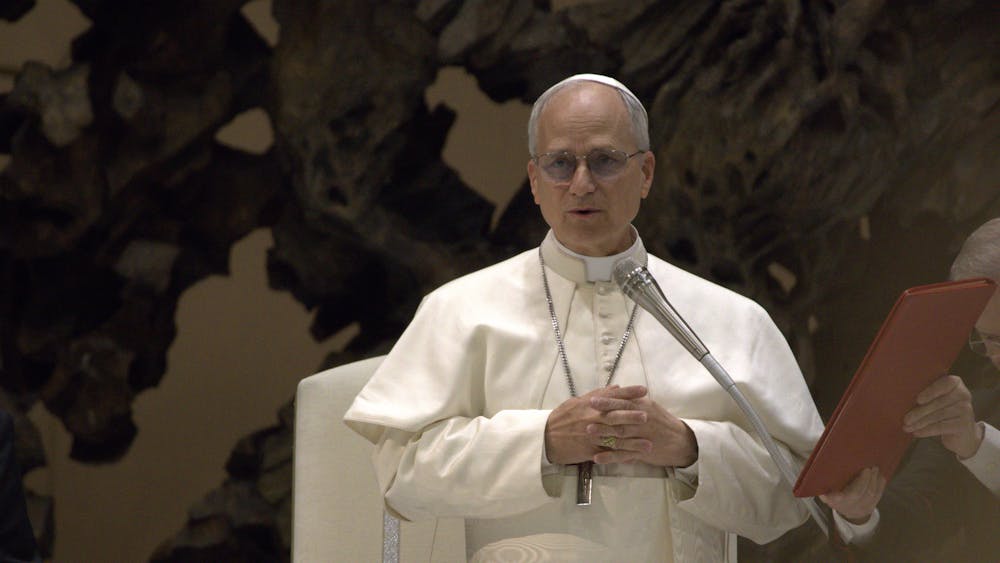As part of the ongoing effort to become a more environmentally friendly campus, the University of Notre Dame said last month its plans to end coal usage on campus are at least one year ahead of schedule.
The campus power plant will cease burning coal sometime in 2019, one year ahead of the initially predicted deadline in 2020, Paul Kempf, Notre Dame’s senior director of utilities and maintenance, said. This recent development is a direct result of the Comprehensive Sustainability Strategy, a multi-pronged plan for a more sustainable campus initiated by the University in 2015 in response to Pope Francis’ 2015 encyclical, “Laudato Si.”
The strategy, created by a standing committee of faculty, administrators, undergraduates, graduate students and campus staff, is organized into six areas of focus: energy and emissions; water; building and construction; waste; procurement, licensing and food sourcing and education, research and community outreach. Each focus area has its own small working group, which creates, enforces and improves the plans in place to meet the sustainability goals unique to each sector.
“The small working groups meet two to three times each semester,” Carol Mullaney, director of continuous improvement for the Office of Continuous Improvement, said. “It’s kind of bringing together this expertise from the faculty’s standpoint and the staff’s standpoint and the interest in a diversity of backgrounds … to come up collectively with a collaborative approach to setting goals, to reviewing our progress against those goals, to determining how to measure them.”
The solution to coal burning, which falls under “energy and emissions” in the Comprehensive Sustainability Strategy, has been many years in the making. In 2010, years before the strategy came about, the utilities department had already created a plan to de-emphasize coal use in the campus power plant by replacing some of the coal with combinations of gas and oil, which can also fuel the machinery.
“The vision in 2010 was to make coal 10 to 15 percent of the fuel input, where it had been 85 to 90 [percent],” Kempf said. “In 2015, when the pope issued 'Laudato Si,' the University decided to re-think that and ask themselves the question of ‘Should we stop burning coal altogether?’”
Kempf’s department was given one week in summer 2015 to answer the question with a feasible timeline for stopping coal usage and an assessment of the potential impacts of such a plan.
Their initial response was a seven-year plan to gradually go coal-free. The administration pushed back, asking if a three-year plan was possible. The resulting compromise was the five-year plan outlined in the Comprehensive Sustainability Strategy, which will now be completed at least one year ahead of schedule.
Nixing coal entirely was a difficult order for the utilities department. The original plans to keep coal as 10 percent of the fuel source had been a means of insurance against potential problems with gas or oil, such as gas eruptions, fluctuating gas prices, gas line failures or oil shortages.
“[Coal] was our backup fuel,” Kempf said. “We had the ability to burn coal, gas and oil. ... We had fuel diversity, which was what gave us both financial strength and operational reliability. So what you're asking us to do is get rid of one of the three legs of a three-legged stool.”
Several changes were made to replace the stool’s third leg.
First, the University focused on strengthening the other two legs of the stool. A new gas line was built to complement the original line into the power plant, and oil storage capacity was doubled in the building.
Even with these changes, it soon became clear the new third leg would have to be renewable energy. Shortly after the five-year plan was approved, the University also announced it would be investing $113 million in renewable energy projects, Kempf said.
Two major projects include the East Plant, described in a University press release as a 30,000-square-foot building that houses the mechanical equipment for the geothermal well fields beneath Ricci Fields, and a hydroelectric facility set to start construction this fall under Seitz Park on the Saint Joseph River in downtown South Bend. Other projects include South Campus, the geothermal well field under the parking lot south of the stadium, which will have corresponding equipment in the basement of the the new architecture building, the largest solar array in South Bend at Kenmore Warehouse in South Bend, and the expansion of the central power plant to house two new gas turbines.
Kempf compared this variety of investments in different renewable energy sources to diversifying a stock portfolio.
“We’ve mapped out ideas that’ll take us all the way to 2050, but what we haven’t done is cast in stone that they’re the right ideas,” he said. “So every five years, we look at this big master plan, and go, ‘What’s changed in technology? What’s changed in our loads? How have our predictions changed? Do we want to rethink this?’ It keeps us nimble.”
Kempf estimated the total cost of all the projects to be around $150 million to $200 million. That money comes from the Infrastructure Funding Plan, which he said does not affect the operating budget of the school.
“It’s a long-term financial plan that had defined resources for funds,” he said. “The point of it is to not have an adverse effect on things like tuition.”
Kempf credits the University’s centralized energy plan, consistency throughout planning and creative flexibility for the successful changes that have been made.
“We’ve taken ownership of energy,” he said. “Everybody’s energy bill hits the budget I’m responsible for. It’s kind of like at home — mom and dad pay the electric bill, the gas bill and the water bill. Well, we’re like mom and dad for everybody.”
Read More
Trending









